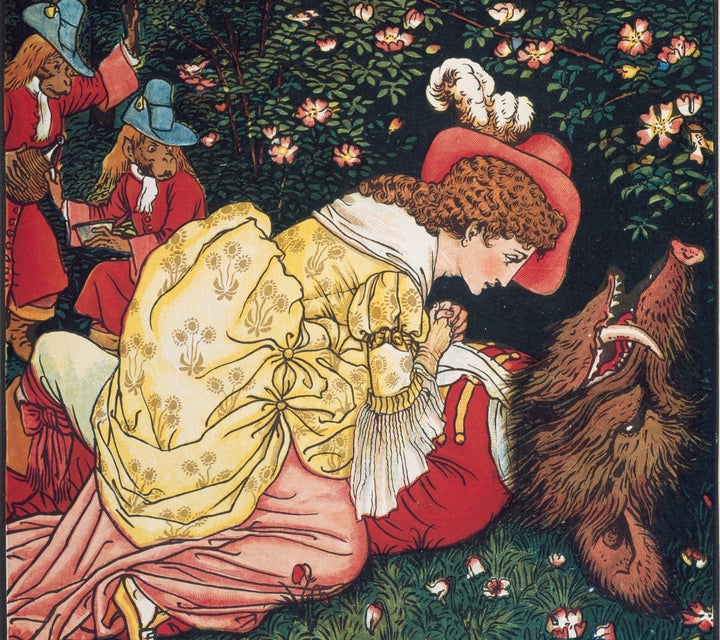
A wealthy merchant falls into penury after his ships founder at sea. He moves his family to the countryside to live a more frugal lifestyle. His six daughters and six sons resent the loss of their comfortable life, their social engagements, and their many admirers. His youngest daughter, Beauty, is the only one to make the best of the circumstances, throwing herself into the daily upkeep of the home in order to keep the family clean and fed. Her older sisters, who are less beautiful and less dutiful, resent her, and they mock her for contenting herself with menial work.
Have you read this story before? Not sure? Here’s just a bit more:
Then, the merchant receives a welcome surprise: One of his ships, thought to be lost at sea, has come safely to harbor with its full cargo. His children think their fortune will surely be restored. When he sets out for the city to deal with his freight, he takes with him requests from his sons and daughters for expensive clothes and other gifts. Only Beauty is hesitant to ask for a gift, and finally asks that he bring her a single red rose.
Now is the story starting to sound familiar? One more hint: A live-action film based on the fairy tale is hitting theaters this week.
Like so many fairy tales, “Beauty and the Beast” has evolved considerably during its journey from oral tradition to the page to the screen. Moreover, there is not only one literary version ― but dozens. Today, Disney-fied fairy tales are most familiar to the masses in their animated forms; the originals, when revisited, can seem comparatively brutal and dark.
Unlike Disney’s “Cinderella” and “Snow White,” however, “Beauty and the Beast” hardly sugarcoats the violence of the original. It’s literally a romance between a captive woman and the monster she at first believes might physically attack her.
Still, the original fairy tale might not sound terribly familiar to readers.
The definitive, most well-circulated version, “La Belle et le Bête,” was composed by Jeanne-Marie Leprince de Beaumont and published in 1756. Her story, a short and sweet tale with a small cast of archetypal characters ― the ingénue, the loving yet hapless father, the protective brothers and jealous sisters, and the hideous but noble-hearted hero.
That’s right: Though Disney’s Belle is an only child, in the classic tale she has siblings. Unsurprisingly, her sisters serve the role of foils for Beauty. She’s gorgeous, they’re merely average-looking; she’s generous, they’re selfish and envious; she’s hardworking, they’re lazy; she’s well-read, they’re frivolous:
The youngest, as she was handsomer, was also better than her sisters. The two eldest had a great deal of pride, because they were rich. They gave themselves ridiculous airs, and would not visit other merchants’ daughters, nor keep company with any but persons of quality. They went out every day to parties of pleasure, balls, plays, concerts, and so forth, and they laughed at their youngest sister, because she spent the greatest part of her time in reading good books.
In Beaumont’s story, Beauty’s father, a ruined merchant, stumbles upon the Beast’s castle when returning from a futile trip to recover profits from a trading ship that unexpectedly returned to harbor. Caught in a storm, he takes refuge in a mysterious castle where he meets no one, but finds food, a fire, and a bed prepared for him. When he leaves, he takes a single rose from the garden to bring Beauty ― which brings the Beast’s wrath down upon him. In exchange for his life being spared, he agrees to return with one of his daughters. Beauty agrees to go, though she’s fearful that the monster will eat her.
Instead, she’s given a lavish chamber and plied with good food and constant entertainments. She never sees anyone ― except in the evening, when the Beast joins her for dinner. She enjoys his sensible conversation, but every night he asks her to marry him, and she refuses. Finally, after several months, she admits that while she’s quite attached to him, she misses her family. The Beast allows her to return home for a visit, but warns that if she delays her return, he will die of grief.
This is where the sisters get extra vicious! Jealous of the finery Beauty wears upon her return, they overwhelm her with affection so that she will miss her deadline, assuming that the Beast will kill her and eat her in his anger. Instead, Beauty returns late and finds the Beast dying of sadness. Seeing him on his deathbed, she realizes that she loves him and begs him to live and marry her. Immediately, he is restored to his handsome, princely self ― and Beauty is rewarded for choosing a virtuous husband over a handsome or witty one. Her sisters are condemned to be living statues outside the castle, forever viewing their sister’s better fortune.
OK, sure, this isn’t too different from Disney’s take. But this is only the beginning. It turns out that Beaumont’s fairy tale was an abridged adaptation of a 1740 story written by Gabrielle-Suzanne Barbot de Villeneuve ― very abridged.
Villeneuve’s “La Belle et le Bête” features monkeys that speak via parrot interpreters (they serve Beauty and keep her company in the palace), five jealous sisters and six brothers, and an exhaustingly elaborate backstory ― revealed at the conclusion of the tale ― involving ugly evil fairies attempting to force handsome princes into marriage, baby princesses being snatched from the cradle, and both fairy and human political struggles for power.
The didactic message of the story is also more heavy-handed, and more retrograde: Beauty has an imaginary lover, a handsome prince who speaks to her in her dreams; in the same dreams, she’s visited by a lovely woman who urges her to look past superficial qualities. Beauty has fallen in love with her dream prince, but the longer she stays with the Beast, as he has demanded, the more sympathetic she feels toward him. Though the Beast in Villeneuve’s version is not only hideous but has been cursed to stupidity, and can barely carry on a conversation, she feels more and more guilty that she doesn’t marry the Beast out of gratitude for the opulent life he’s provided for her and the love he feels for her. Finding him dying of grief:
She regretted her conversations with the Beast, unentertaining as they had been to her, and what appeared to her extraordinary, even to discover she had so much feeling for him. She blamed herself for not having married him, and considering she had been the cause of his death ... heaped upon herself the keenest and most bitter reproaches.
It’s worth noting that the Beast himself spurned the love of an ugly fairy who fell in love with him. She curses him in retaliation, imprisoning him in a beast’s body ― but while this makes her the villain of the story, Beast’s imprisonment of the woman he hopes to marry is painted as kind and generous. Belle isn’t granted the luxury, like the Beast, of rejecting an unattractive suitor; she’s expected to learn to accept his love. Ultimately, she decides to marry him because she owes him and is fond of him, proving her virtue by denying her own desires and choosing instead a man who’s earned her through his love and gifts.
In short, the Beast may have been the original Nice Guy™!
Those two stories don’t cover the full breadth of “Beauty and the Beast” tales. Some believe the roots go back thousands of years, and many cultures have some variety of the story.
In the Italian rendition, “The Pig King,” written in the mid-16th century by Giovanni Francesco Straparola, a queen is cursed to have a son who appears as a pig until he’s been married three times. When he’s grown, his mother convinces the first daughter of a poor family to marry him, but the girl is horrified at the match and tries to kill him on the wedding night. He tramples her with his hooves, killing her instead. The same happens to her younger sister. Then he marries the virtuous youngest sister, who is kind and accepting of her new husband. At night he reveals himself as a handsome young man to her, and the couple eventually rules the kingdom together. Yes, despite the fact that he literally stabbed her two sisters to death with his hooves, the girl falls in love with him.
A truly bonkers Norwegian fairy tale, “East of the Sun, West of the Moon,” stars a white bear who convinces a peasant to give him his youngest, prettiest daughter. At night, he comes and sleeps with her as a man, though she can’t see him. One night, she lights a candle to see his face, but drips hot tallow on him and wakens him. As a consequence, he has to marry his evil stepmother’s choice for him: a troll princess. But his young lover refuses to give up, following him to the troll kingdom and winning his hand through trickery ― at which point the troll princess explodes in rage. (Literally, she explodes.)
In many of these older versions, Beauty is distinguished most by her docility and selflessness. Even her bookishness, so heavily played up by Disney, is merely one aspect of her dutiful feminine lifestyle ― she plays a variety of instruments, enjoys art and the theater, and amuses herself in the country by “dress[ing] her hair with flowers” when she’s not cheerfully caring for the home. Other female characters who privilege their own desires are portrayed as spoiled and even cruel, and aside from elevating Beauty as the one deserving woman, they often serve the function of disposable vessels for male needs (see: those two poor women who are trampled to death by a pig).
The Beast might prove his worth through devoted love, but Beauty proves hers through submerging her own passions and awarding herself to the most worthy suitor. The message is clear: Women should love the ones they’re with, no matter how seemingly repulsive ― it’s all part of the life of extreme self-sacrifice that makes them worthy of happiness and respect.
Disney’s “Beauty and the Beast” tweaked this story, making Belle an unconventional bookworm with an independent streak rather than a pretty, submissive maiden. It relegated the unsympathetic, frivolous female role to a chorus of silly village girls who swoon over Gaston, rather than making a cruel sister central to the story. Emma Watson, who portrayed Belle in Disney’s live-action remake, has openly hinted that the new, updated heroine will be still more brilliant and self-reliant.
Certain aspects of the story, though, will remain ― and some of the most shocking and controversial aspects of the story are the very plot points that make it “Beauty and the Beast.” When it comes right down to it, every version is essentially the same story: A beautiful woman redeems her hideous captor with her love ― parrot/monkey servants optional.
